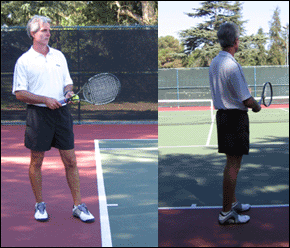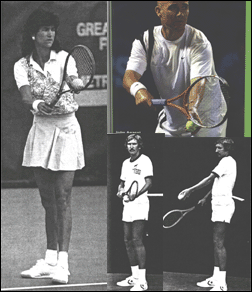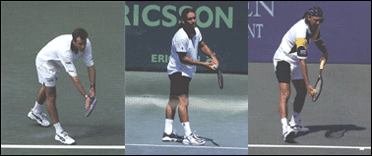Revolutionary Tennis |
||
Tennis Instruction That Makes Sense |
||
Step 12 The Tennis Serve Part 1: The Service Stance THE SIMPLE SERVICE STANCE
The Establishment orders a service stance In-Conflict. You start turned to the side but the conflict occurs when you point your racket at the service box because now your upper body faces the service box but your lower body faces off to the side. You're twisted. Adding to the conflict the front foot is at an angle to the baseline but the back foot is parallel to it, leaving you splay footed. Quack-quack. Why the stance In-Conflict? Because you are told to point your racket at your opponent. But do you have to? No. Is there an advantage with it? No. Why do it then, because it's historical? Beats me.
[pros above USTA high performance newsletter, Vol.4, No. 1/2002; agassi on the right TENNIS magazine, 7/2004, part of an advertising section; USPTA girl from their ADDvantage magazine, date not saved; Vic's model from Vic Braden's Tennis for the Future, 1977.] If you start with your body twisted with the stance In-Conflict there are two ways to serve. You keep your upper body still and turn your lower body forward to face the service box to match your upper body and begin your serve motion from there, or you can re-turn your upper body to the side to match your lower body turned to the side and then start your motion. The latter is what you do. And it is precisely here at this early point in the serve that your wheels fall off the track, before you've really started anything. Why not avoid having to readjust or reconcile or compensate for being twisted in the first place? Why not start with your entire body in a normal, natural position since you are turned to the side? Why point your racket to the service box when this is the gesture that leads to the conflict? Why not point the racket off to the side and avoid this whole mess? There is no need to place the ball on the strings, doing so extends your toss arm too far away from the body and leads to imbalance (your toss arm straightens and your body leans forward instead of keeping its weight on the back leg). The toss arm should be bent and relaxed, not stretched, it has a lot of work to do. The racket arm can benefit from stretching forward a bit more. The ball will find its way on the racket's throat or bottom of the face, wherever you feel comfortable with it. If you're comfortable with it in the middle of the racket face that's fine too, but make sure it doesn't mess with your weight shift. Simple Service Stance. Stand tall. Stand up. Shoulders back, relaxed. Taller. Point your racket to the net post to your side and WITHOUT extending the arms. And before you begin exhale completely, let it out.
TO ROCK OR NOT TO ROCK...? THERE IS NO QUESTION During the serve process the weight goes forward, just like throwing or kicking a ball. Why not start with your body weight on the back foot? This idea moves you only in one direction, keeping things simple. Why rock back to the back foot to then rock forward to the front foot? Many pros start with their body weight on the front foot, but if you're trying to improve your serve you need to simplify and that means starting with the weight on the back foot. Two things of note. First, the serve is the only stroke where we are standing still, we don't get to move to the ball. As a result there is no rhythm building for the stroke, standing still feels awkward. That's why you see the guys and girls bounce the ball on the court or bounce around a bit while getting ready to launch the stroke, or you see funny feet. They're trying to deal with the lack of rhythm. If they bounce the ball their weight will be on their front foot, and when they stop bouncing it their weight goes back onto their back foot and comes right back forward during the toss sequence. Second, the pros get their body weight shifting forward during the toss, something that is lost on students. Students often shift their weight back during the toss sequence instead of forward, losing the set-up for power. Why not eliminate the rocking motion to simplify your serve? Start on the back leg. If you work your serve this way you will eventually develop your own little back-and-forth-something-or-other rhythm filler, and all on your own without prompting from anyone. I can't tell you how your rhythm filler should or will be, you will find it all on your own. But I can show you the road to travel to find it. If twist not, quack not, then rock not. Excellent. Be yourself. Ready to serve? There's a pattern to follow every time. See if your opponent is ready by only turning your head in that direction and not the upper body or racket and then return the head back to its starting position facing away from the opponent. Exhale completely. Look at the ball in your hand (can be optional). Look up a bit in the direction of your toss, that is north of the horizon before you begin your tossing sequence ("arms down together"). The toss arm goes down and up and when you toss the ball the ball enters your field of vision. Point is don't watch the ball go down in your hand when the toss arm goes down and then watch it coming up, you lose your balance and rhythm. Look up first, then do the toss sequence. Next: Holistic (& click here please). Please click to "allow blocked content" when MS Explorer warns you there is "active content" on the page, i.e. rollovers and such. |
||
|
|
||||||||||||||||||||||||||||||||||||||||||||||||||||||||||||||

 Andre Agassi on the far right starts this way, it's all too common. The girl on the left is a USPTA member, the guy on the lower right illustrates Vic Braden's ideas in his book. Not to be outdone, I also include Ivanisevic, Rusedski, and Rios all serving from the deuce court and clearly facing and pointing the racket to the deuce court instead of off to the side per their stance.
Andre Agassi on the far right starts this way, it's all too common. The girl on the left is a USPTA member, the guy on the lower right illustrates Vic Braden's ideas in his book. Not to be outdone, I also include Ivanisevic, Rusedski, and Rios all serving from the deuce court and clearly facing and pointing the racket to the deuce court instead of off to the side per their stance.
